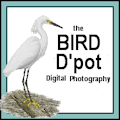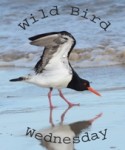Posted by: Ken @ 12:23 pm
The past few weeks have kept us occupied with the welfare of the downed Bald Eagle chick (now presumed to have perished– follow events at our nest watch FORUM) and that of the heron nests in trees that are dead or dying from the effects of a herbicide.
Add to this my dismay in witnessing the destruction of one of my favorite warbler birding spots, the place I called the “Fake Hammock.” (To see it in happier times, visit “Birding in a make-believe hammock“) Now a “roadway” has been cut all the way through the grove of trees.
A large open area has been created by removal of most of the underbrush, and worst of all, the secluded area is being ravaged by “sport” riders of all-terrain vehicles. Instead of a dark cool place under a canopy of native Trema trees, it is now shaped like a doughnut, with full sky overhead, and a fire ring in the middle. Two of the five mature Tremas have been pulled over with chains, presumably attached to the ATVs, and a third is badly de-barked and will surely die. Tremas produce berries continuously all winter and are an important food source for birds and other wildlife. 
On a happier note, we have headed north, and hope to catch up with the spring warbler migration that, this year, has bypassed our Florida home.
Just before we left Florida, The first Yellow-crowned Night-Heron chicks began hatching. There were two chicks visible in this nest, which is totally open to view because of the defoliation of the nest tree by herbicides (See: Courting herons unaware of danger). Last year the nests were barely visible through the leaves. Now they are exposed to predators and any rock-throwing vandals who happen to notice them from across the 30 foot canal.
Look closely at the above photo and notice that one of the 3-5 day old chicks is trying very hard to swallow something that is awfully big. 
The prey item looks like a fat white creature– maybe a horsefly larva, but I could not be sure, as it looks larger, more the shape of a siren that has been skinned. Whatever it is, it may have been partly digested by the parent. The parent bird attempted to pull the partially-swallowed item out of
the chick’s mouth, but, despite its small size the chick resisted the adult’s attempts to dislodge it from its gullet, protesting vigorously.
Initially, the parentt’s efforts did not succeed. 
A few minutes later I captured this short video clip that demonstrates that the little guy finally gave up the prize, which was quickly swallowed by its parent.
Baby Yellow-crowned Night-Heron almost chokes to death from Ken Schneider on Vimeo.
If you have trouble viewing this VIMEO clip, here is a direct link to it on FLICKR.I have accumulated a backlog of non-heron and non-eagle images from our recent morning walks in our local wetlands. Among them:
Common Nighthawks arrived during the past two weeks.

Their flight is so erratic and unpredictable that it is very hard to catch them in the viewfinder, much less get a decent photo when they are on the wing.

Here, the first light of morning creeps underneath an overflying nighthawk.

A male Eastern Towhee sings on territory. Its yellow eyes indicate that it is a local bird.

As usual, I do not pass by an opportunity to photograph a singing male Northern Cardinal.

This year, for the first time, we heard and saw Pileated Woodpeckers in our neighborhood. I finally find one out in the open.

A flock of Cattle Egrets is joined by a lone Snowy Egret.

Another Snowy Egret casts its reflection in the stillness of a misty morning.

A Little Blue Heron is changing from the white phase of a juvenile into dark adult plumage .

Nearby, a Great Egret barely disturbs the calm waters.

A pair of Mottled Ducks will also nest along the shore. The male, showing a clear yellow-green bill, is on the right.

Later in the morning, a Killdeer flies by,

Killdeer may be planning to nest on this spit of land that has been exposed by the dropping water levels.

I am pleased to find a native Green Anole in our birding patch. They have been almost entirely displaced by exotic Brown Anoles.

A Black Vulture is graceful in flight.

A yearling female White-tailed Deer eyes us from the edge of a dense tract of exotic Melaleuca trees.

A curious (and presumably near-sighted) Raccoon stands on one foot, trying to figure out who is right in front of him/her in the trail:

A Queen butterfly sips nectar from a Lantana flower













